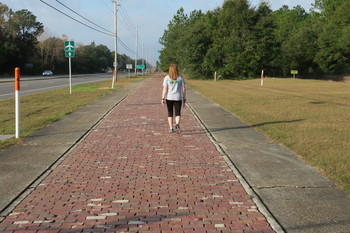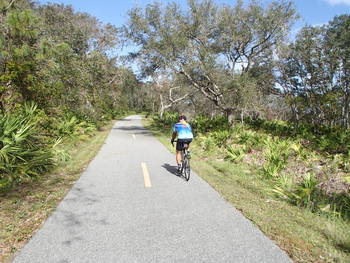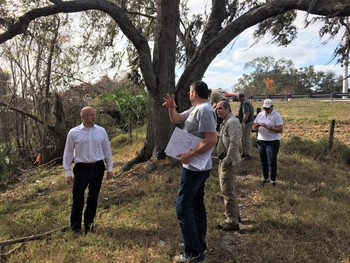Winter 2018

A five mile red brick section of the Old Spanish Trail near Milton that is now a hiking and biking trail.
After
several months of public input and 14 regional workshops held throughout the
state by the Office of Greenways and Trails (OGT), the Florida Greenways and Trails Council adopted the 2018-2022
Maps for the Florida Greenways and Trails System at its Jan. 11 meeting in Tallahassee. Major changes and additions to the
updated priority trails map include a new conceptual multi-use trail corridor
along U.S. 90 across the state, which was originally part of the Old
Spanish Trail from San Diego to St. Augustine.
Several
priority map additions were made in Northeast and Central Florida to create more regional
trail networks and loops. In South Florida, an east-west route that skirts the southern rim of Lake
Okeechobee is also included in the new plan. In Southeast Florida, several shorter additions will help create
regional trail loops in highly urbanized areas. The proposed paved priority
multi-use trails will be eligible for funding from the Shared-Use Nonmotorized (SUN) Trail
Network program managed by the Florida Department of
Transportation.
For paddlers, an expanded Perdido River Paddling Trail was
adopted as a priority trail in recognition of efforts by the Nature Conservancy
and the state of Alabama to add river camps along
the upper and lower portions of the river.
Hiking
trail changes include a planned re-route of the Florida National Scenic Trail
from several back roads to an extensive network of public lands in the Suwannee
River Valley and along the Big Bend Coast. A conceptual hiking trail through
the Florida foothills along the Apalachicola River from Bristol to
Chattahoochee was added to the opportunity trails map.
The Council also approved Dunedin as the first recognized Trail Town under the new Florida Trail Town Program managed by OGT.

Florida
now has 2,545 miles of hiking trails open to the public in addition to 4,708
miles of shared-use trails available to hikers. Hiking opportunities in Florida include the 1,100-mile Florida National Scenic Trail, one of 11 congressionally designated National Scenic Trails
in the United States. Florida celebrates Hiking Trails Month in February,
when low humidity and few bugs make it a great time to be outside.
In March, the state celebrates Florida Bicycling Month. With Florida’s ever expanding system
of mountain bike and paved off-road trails, opportunities are numerous for safe
and adventurous cycling. Several cycling festivals are held throughout
the state during the year, so be sure to peruse the Office of Greenways and
Trails online
calendar to find an event near you.
 Eric Draper (far left) walks with DEP Secretary Noah Valenstein (far right) and others on the 2018 First Day Hike at Maclay Gardens State Park.
Article by Eric Draper, Florida Park Service Director
On New Year’s Day I was one of the thousands around the
nation who bundled up and joined companions for a state park first day hike. It
was a joy to be with others and start the year using my legs to get around. I
still remember the turns in the trail, the birds and the conversations. Parks and trails are places where memories
are made.
The hike I joined was one of more than 100 in Florida and
many more around the nation. The online photos were fascinating – families and
friends making the best of a new day. My
favorite was parents pushing a toddler in stroller through the woods. What a
great way to combine the values of being outdoors and together.
As a new director of the Florida State Parks, which includes
the state’s expanding network of greenways and trails, I am excited to be part
of the cause of getting people moving outside. I believe deeply that walking,
cycling, running, swimming, padding and looking at nature are essential to
human happiness.
I have also come to appreciate that Florida’s Department
of Environmental Protection is committed to providing safe access to our parks
and trails. A doctor once told me that a sports injury would cripple me for
life. In overcoming that dire prediction
and the gloomy outlook, I learned the joy of movement even if it meant swinging
along on crutches. My legs now get me around okay, but when I see other people
whose mobility is limited enjoying our parks and trails, I am reminded of the
healing power of nature and movement. Our trails allow us to make every hike a
new day.

Article by Brian Smith, Florida Greenways and Trails Foundation
The trail movement in Florida is gaining momentum. It was
boosted by a Florida Coast-to-Coast Trail initiative to connect the Gulf and
Atlantic Coasts by filling in gaps of existing trails. The foundation was
involved in these initial activities that soon led to the Shared-Use Nonmotorized (SUN) Trail Network, a state-funded
program.
These efforts have resulted in regional trail initiatives
modeled after the Florida Coast-to-Coast Trail program. Funding comes not only from the state, but
also from many local communities that are investing their resources in trails.
The most recent example is the Pinellas County vote in November to extend its sales tax another 10 years, a referendum that passed with 83 percent approval. This tax extension will pay for the completion
of the Pinellas Trail loop as well as a host of other community projects. Another example is the recently completed paved segment of the Cross Florida Greenway.
That trail starts at the Santos trailhead, just south of Ocala, and proceeds
for 15 miles west almost to State Road 200. There are many other examples we will talk about in future articles.
Several reasons account for such widespread support. Trails
provide a safe environment for cyclists, walkers and skaters. In addition to recreational use, trails
provide means of travel for many other purposes. Two-thirds of trail users in
urban areas are making trips for work, school, shopping, social or other
purposes.
Trails demonstrate their value in connecting communities;
reducing greenhouse gas emissions; offering safe, economic ways for people to
travel; and creating opportunities for outdoor exercise and enjoyment.
It is an effort worthy of our continued support.

DEP Secretary Noah Valenstein (far left) visits the Shingle Creek property with county officials and trail users.
Governor Scott and the Florida Cabinet approved the acquisition
of a 1.3-mile connection to the Shingle Creek Regional Trail (SCRT) on December 13. The
35.2-acre parcel, purchased through OGT's acquisition program, will join two distinct segments of the SCRT and will provide
greater recreational access to the picturesque Shingle Creek Watershed and Lake
Tohopekaliga.
"Strategic acquisitions like this one are vital to making a
positive impact on communities while preserving our natural resources," said
DEP Secretary Noah Valenstein. "The department is looking forward to
partnering with local communities to expand our trail connections to allow even
more Floridians and visitors to enjoy Florida’s beautiful natural landscapes
through our nationally renowned system of trails."
|